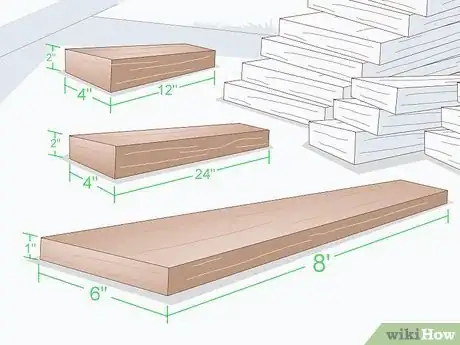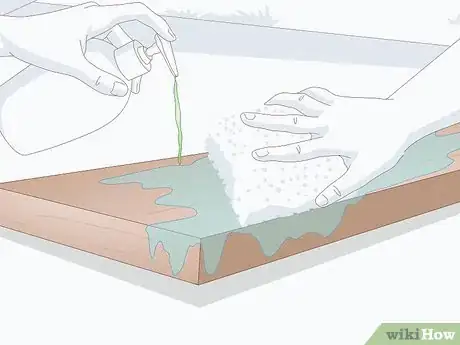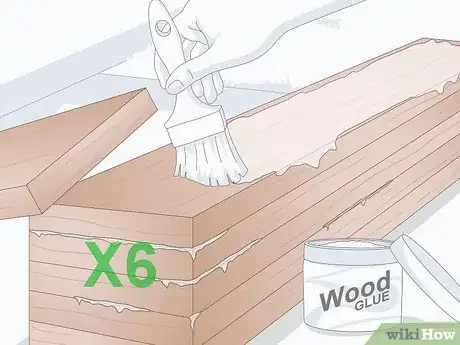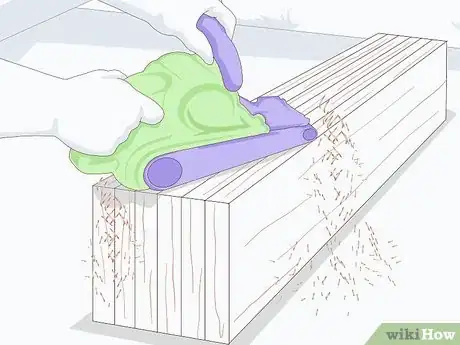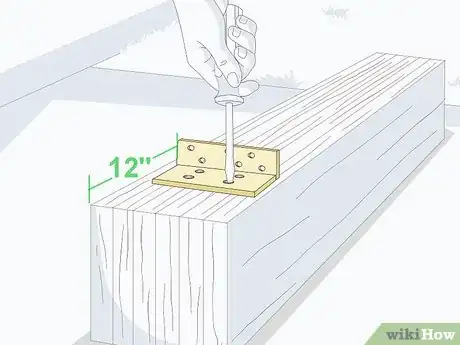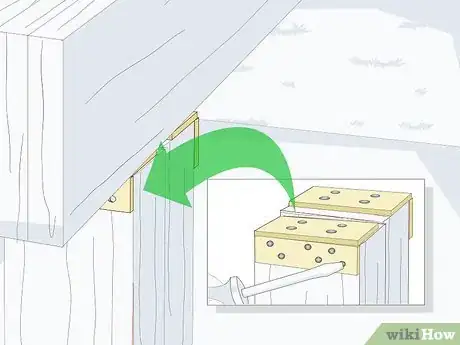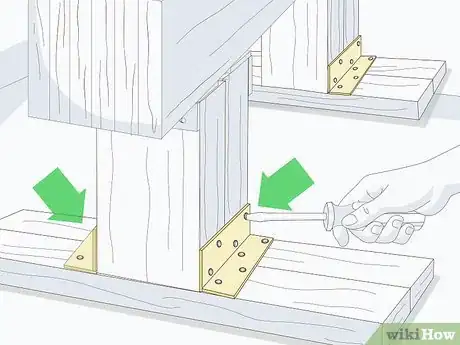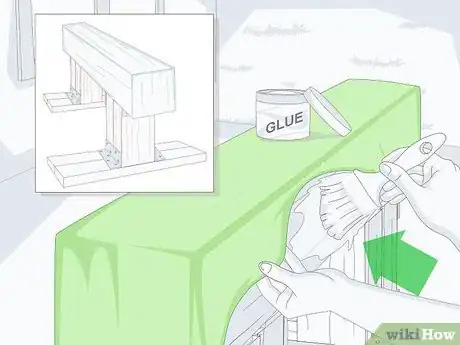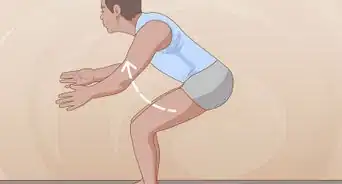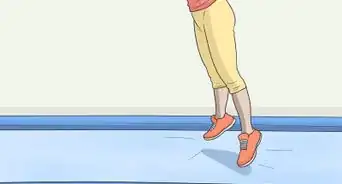wikiHow is a “wiki,” similar to Wikipedia, which means that many of our articles are co-written by multiple authors. To create this article, 24 people, some anonymous, worked to edit and improve it over time.
wikiHow marks an article as reader-approved once it receives enough positive feedback. In this case, several readers have written to tell us that this article was helpful to them, earning it our reader-approved status.
This article has been viewed 466,102 times.
Learn more...
Balance beams can be a critical skill to master for gymnasts of any age. They teach younger students agility and balance while still offering a wide range of challenges for even the most accomplished gymnast. Learning how to make a balance beam can allow your gymnast the opportunity to practice more frequently from the comforts of home.
Steps
Making the Beam
-
1Purchase the required lumber from your local hardware supplier. To build the balance beam you will need six 8 foot (2.44 m) pieces of 1-by-6 pine beams, four 12-inch (61 cm) pieces of 2-by-4 wood planks and four 24-inch (30.5 cm) pieces of 2-by-4 wood planks.
- You will also need to purchase everything listed below in "Things You'll Need". These items can all be found at your local hardware supplier or stores such as Home Depot and Lowes.
-
2Wash the entire surface area of each wood piece. Use soap, water and a washcloth, sponge or coarse brush to scrub the wood pieces thoroughly. This is very important as dirt and grime can prevent the wood glue from working as effectively. Let the wood sit for a while until it is completely dry before adding the glue.Advertisement
-
3Glue the six 8 feet (2.4 m) wood pieces together. Place the pine beams vertically next to one another as that is how they will need to be administered. Glue the largest sides (the flat sides with the most surface area) of the wooden beams together with an industrial-strength wood glue (preferably waterproof). Use a very generous amount of glue in this process as that is what keeps the wood beams together. Make sure they dry before the next step![1]
- When finished the fronts and backs of the beams should be completely flush, creating 1 large beam measuring 8-feet (2.44 m) long and around 4.5-inches (10.2 cm) wide.
- The 4.5-inch (10.2 cm) surface will be the top of your homemade beam.
-
4Secure the beams together while the glue dries. The best solution for securing the beams together is to use wood clamps. If you don't have clamps, lay the beams flat on their widest part and apply a heavy weight to help fuse the boards.[2]
- Allow the beams to dry for at least 24 hours.
-
5Sand the wood. When the glue has dried, remove the clamps or the weights, and sand the entire surface of the beam.[3]
- Use a sanding plane or sand belt to ensure the surface is uniform and even.
-
6Mount steel galvanized angle holders to the beam. Screw the angle holders (the angle holders will come with screws) to the underside ends of your balance beam approximately 12 inches (30.5 cm) from the end of each side.[4]
Adding the Base
-
1Add legs to the beam. Fasten the four 12-inch (30.5 cm) pieces of 2-by-4 wood planks into the angle holders to create the legs, using 4 wood screws per leg, or 16 screws total.[5]
- There should be 4 available spaces in the angle holders, 1 for each leg.
-
2Anchor the base for each leg. Attach one 24-inch (61 cm) piece of 2-by-4 wood plank to the bottom of each leg, using 4 total, with 4 wood screws per anchor.
- These will ensure greater stability and a balanced surface.
-
3Cover with synthetic suede padding. Cut a long, thin strip of the suede padding to fit the length and width of the beam. Glue the padding onto the surface so it covers the entire beam.[6]
- For optimal results, use a piece wide enough to fit all the way around the beam with enough left over to fasten to the underside with the angle holders.
- Allow the padding and glue to fully dry before using the beam.
Community Q&A
-
QuestionDo you have any suggestions on how to find synthetic suede?
 Community AnswerGo to a fabric/craft store and ask an employee for help. You can also order it online.
Community AnswerGo to a fabric/craft store and ask an employee for help. You can also order it online. -
QuestionWould cedar work well as a balance beam?
 Community AnswerYes, but cedar is an expensive and softer wood that could be dented by your shoes. However, cedar is also more stable outdoors than a standard SPF plank.
Community AnswerYes, but cedar is an expensive and softer wood that could be dented by your shoes. However, cedar is also more stable outdoors than a standard SPF plank. -
QuestionDo you have to put anything over the beam?
 Community AnswerYou should, so you have a soft landing when you are doing a skill and so you don't get splinter.
Community AnswerYou should, so you have a soft landing when you are doing a skill and so you don't get splinter.
Warnings
- Thoroughly test your new balance beam before performing rigorous routines. The beam is only as good as the craftsmanship, and to avoid serious injury take great measures to ensure it is solid and can hold up under pressure.[7]⧼thumbs_response⧽
Things You'll Need
- Soap and water
- Six 8-foot (2.44 m) pieces of 1-by-6 pine beams
- Waterproof wood glue
- Wood clamps or heavy weights
- Sanding plane or sand belt
- Galvanized angle holder and screws
- Four 12-inch (61 cm) pieces of 2-by-4 wood planks
- Four 24-inch (30.5 cm) pieces of 2-by-4 wood planks
- Screwdriver
- 32 wood screws
- Synthetic suede padding (optional)
You can also add duct tape to a regular mat for a stripe beam!
References
- ↑ https://www.justagirlblog.com/how-to-build-a-balance-beam/
- ↑ https://www.justagirlblog.com/how-to-build-a-balance-beam/
- ↑ https://sportsaspire.com/how-to-build-balance-beam
- ↑ https://gymnasticslab.com/5-steps-how-to-make-a-balance-beam-for-kids/
- ↑ https://gymnasticslab.com/5-steps-how-to-make-a-balance-beam-for-kids/
- ↑ https://sportsaspire.com/how-to-build-balance-beam
- ↑ https://sportsaspire.com/how-to-build-balance-beam
About This Article
To make a balance beam, first glue six 8-foot pieces of wood together for the top. When the glue has dried, sand the wood and mount angle holders underneath the ends of your balance beam. Then use wood screws to fasten four 12-inch pieces of 2x4 planks into the holders for the legs. Make a stable base for your balance beam by attaching one 24-inch piece of 2x4 plank to the bottom of each leg. Finish your balance beam by covering it with synthetic suede padding. For more information on making a balance beam, including how to prepare the wood before you start, read on!
